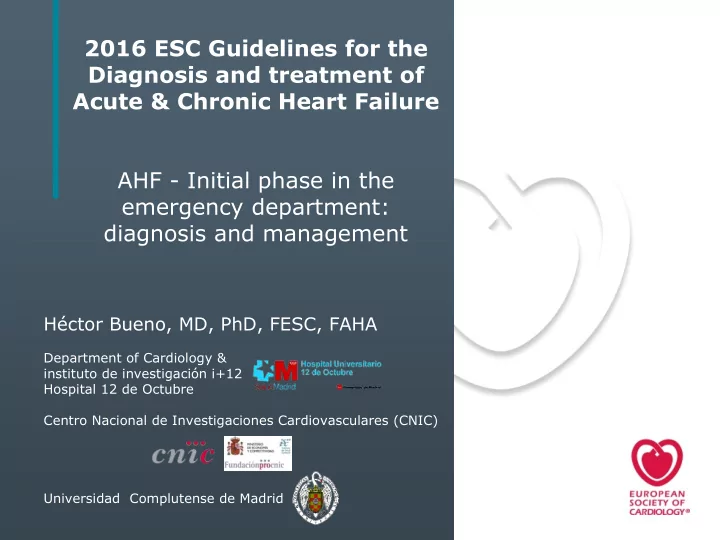

2016 ESC Guidelines for the Diagnosis and treatment of Acute & Chronic Heart Failure AHF - Initial phase in the emergency department: diagnosis and management Héctor Bueno, MD, PhD, FESC, FAHA Department of Cardiology & instituto de investigación i+12 Hospital 12 de Octubre Centro Nacional de Investigaciones Cardiovasculares (CNIC) Universidad Complutense de Madrid
DISCLOSURE Dr. Bueno reports having received consulting/speaking fees from Abbott, Astra-Zeneca, Bayer, BMS-Pfizer, Daichii-Sankyo, Eli-Lilly, Ferrer, Menarini, Novartis, Sanofi, Servier, and research grants from Astra-Zeneca. www.escardio.org
www.escardio.org
AHF - Definition and classification AHF refers to rapid onset or worsening of symptoms and/or signs of HF De novo vs Acute decompensation of chronic HF • Primary cardiac dysfunction • - Acute myocardial dysfunction (ischaemic, inflammatory or toxic) - Acute valve insufficiency or pericardial tamponade (and/or) With / without known precipitant factors www.escardio.org Speaker
Factors triggering acute heart failure www.escardio.org
Diagnosis and initial prognostic evaluation The diagnostic workup needs to be started in the pre-hospital • setting and continued in the emergency department (ED) in order to establish the diagnosis in a timely manner and initiate appropriate management. In parallel, coexisting life-threatening clinical conditions • and/or precipitants that require urgent treatment/correction need to be immediately identified and managed. Typically, an initial step in the diagnostic workup of AHF is to rule • out alternative causes for the patient’s symptoms and signs (i.e. Pulmonary infection, severe anaemia, acute renal failure). www.escardio.org Speaker
Initial management of patients with acute HF www.escardio.org
Initial management of patients with acute HF (1) www.escardio.org
Initial management of patients with acute HF (1) www.escardio.org
Recommendations for the management of patients with AHF: oxygen therapy and ventilatory support www.escardio.org
Initial management of patients with acute HF (1) www.escardio.org
Initial management of patients with acute HF (2) www.escardio.org
Initial management of patients with acute HF (2) www.escardio.org
Diagnosis and initial prognostic evaluation 1. Assessment of symptoms and signs - Fluid overload (pulmonary congestion and/or peripheral oedema) - Reduced cardiac output with peripheral hypoperfusion - Sensitivity and specificity often not satisfactory 2. Additional investigations - Laboratory tests at presentation: Natriuretic peptides § Plasma NP level (BNP, NT-proBNP or MR-proANP) should be measured in all patients with acute dyspnoea Thresholds: BNP <100 pg/mL (vs 35 pg/mL in the chronic setting) NT-proBNP <300 pg/mL (vs 125 pg/mL ” ) MR-proANP <120 pg/mL www.escardio.org Speaker
Causes of elevation of natriuretic peptides levels www.escardio.org
Diagnosis and initial prognostic evaluation 1. Assessment of symptoms and signs - Fluid overload (pulmonary congestion and/or peripheral oedema) - Reduced cardiac output with peripheral hypoperfusion - Sensitivity and specificity often not satisfactory 2. Additional investigations - Laboratory tests at presentation: Natriuretic peptides § Plasma NP level (BNP, NT-proBNP or MR-proANP) should be measured in all patients with acute dyspnoea Thresholds: BNP <100 pg/mL (vs 35 pg/mL in the chronic setting) NT-proBNP <300 pg/mL (vs 125 pg/mL ” ) MR-proANP <120 pg/mL Other laboratory tests. § cTn, BUN or urea, creatinine, electrolytes (sodium, potassium), liver function tests, TSH www.escardio.org Speaker
Diagnosis and initial prognostic evaluation 2. Additional investigations - ECG - Underlying cardiac disease and potential precipitant (AF, ischaemia) - Rarely normal in AHF (high negative predictive value). - Chest X-ray - Nearly normal in up to 20% of patients with AHF - Rule out alternative non-cardiac diseases - Echocardiography Within 48 hours (optimal timing uncertain Immediate if haemodynamic instability (i.e. cardiogenic shock) or suspected acute life-threatening structural/functional CV abnormalities - Bedside thoracic ultrasound (signs of interstitial oedema and pleural effusion) may be useful in expert hands www.escardio.org Speaker
Recommendations regarding the use of diagnostic measurements www.escardio.org
Management of patients with acute heart failure based on clinical profile during an early phase www.escardio.org
Clinical profiles of patients with AHF based on the presence/absence of congestion and/or hypoperfusion www.escardio.org
Management of patients with acute heart failure based on clinical profile during an early phase www.escardio.org
Management of patients with acute heart failure based on clinical profile during an early phase www.escardio.org
Recommendations for the management of patients with acute heart failure: pharmacotherapy www.escardio.org
Initial management of patients with acute HF www.escardio.org
Recommend
More recommend